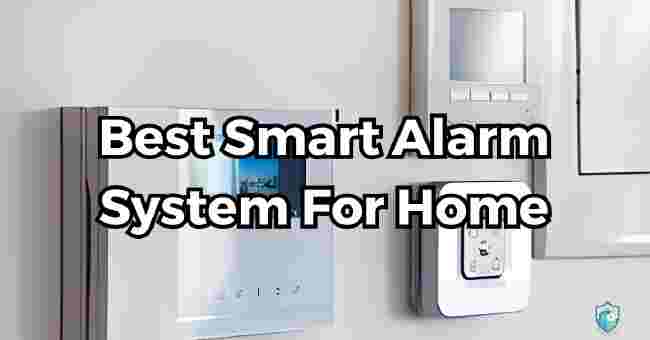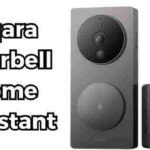Table of Contents
Are you wondering what is the best smart alarm system for home? Yes, As a first-time homeowner constantly worried about protecting my new place, I struggled with this question for months.
After having my bicycle stolen from my backyard, I knew I needed to amp up security.
Unfortunately the options felt totally overwhelming – DIY sensors? Professional installation? Monthly fees forever? My mind spun.
Finally, I narrowed it down thanks to my techie brother who had researched options for his home.
After digging into pro/con breakdowns, seeing his SimpliSafe setup in action, and understanding what integrations mattered most for my smart appliances, the decision clicked.
Now I can’t wait to share my insight so you pick the perfect system faster than I did.
Securing Your Castle: Key Features For Best Smart Alarm System For Home
Smart security systems connect all your monitoring devices to give you 24/7 real-time access and control from anywhere.
Key features to look for include:
- Remote Access and Control
- Instant Alerts and Notifications
- Live Video Streaming
- AI Motion Sensing
- Encrypted Data Storage
Remote Access and Control
Mobile apps and web portals allow you to arm, disarm, and check system status even when you’re out via Alexa, the Google Assistant app on your phone. It’s a game changer for peace of mind!
Instant Alerts and Notifications
Get immediate alerts if any sensor is triggered so you can verify and act quickly. Alert priority can usually be customized in the app.
Live Video Streaming
Visual verification is huge with indoor/outdoor security cameras. Systems like Ring allow you to pull up a live video feed and even speak through the camera.
AI Motion Sensing
Advanced motion sensors use AI technology to distinguish intruders from pets or environmental motion, reducing false alarms.
Encrypted Data Storage
Opt for systems like Abode or SimpliSafe that offer advanced encryption to keep your personal data private.
Arming Your Smart Fortress: Sensors to Detect & Deter Intruders
Integrating smart sensors is key for maximum security. Consider these sensor options:
- Entry sensors on all exterior doors/windows to detect break-ins
- Motion detectors (indoor & outdoor) to catch unwanted visitors
- Smoke, CO alarms, leak detectors ensure you’re covered for environmental threats as well
- Pet-friendly sensors prevent false alarms if you have rambunctious furry friends!
- Image recognition in cameras that can differentiate people from objects/animals
- 2-way audio features let you yell at intruders to scare them off!
I always recommend placing multifunction motion sensors on each level of the home for more complete coverage.
Connecting the Security Dots: Integration with Other Smart Devices
Linking various smart devices takes your security to the next level:
- Automated Lighting, Lock Control
- Sensor-triggered Deterrents
- Location Based Control
Automated Lighting, Lock Control
Set your system to automatically turn lights on if motion sensors activate after hours or ensure doors are locked when you leave via Z wave connected smart locks.
Sensor-triggered Deterrents
Connecting devices allows for automated theft deterrents – like setting cameras or sirens to activate if a window sensor detects an intrusion.
Location Based Control
Leverage options like geo-fencing through the Vivint app to have your system arm/disarm based on your phone location. Approach with caution so you don’t arm it accidentally.
DIY vs Pro Installation: Key Decision Factors
The option to self-install security devices vs having professional setup is the most significant choice you’ll make.
- Ease of DIY Install
- DIY Flexibility and Affordability
- Downsides of DIY
- Professional Installation Services
Ease of DIY Install
Systems from SimpliSafe, Ring, Abode make self-installation super simple with peel-and-stick sensors, wireless syncing.
I installed my SimpliSafe system in under an hour with their detailed app guidance.
Their setup also allows me to scale/adapt coverage as needed by just plugging in new devices.
DIY Flexibility and Affordability
The main perks of DIY systems are the flexibility to pick the devices you want while avoiding expensive professional monitoring fees. I love only paying for equipment with no long term contract.
Downsides of DIY
The caveat is that you trade off professional guidance and installation. If the sensitivity isn’t calibrated well, too many false alarms can be frustrating to manage. Tech glitches can also be hard to troubleshoot solo!
Professional Installation Services
Alternatively, pro install companies like ADT and Vivint offer an app but handle the entire equipment setup process for you:
- Security assessment of vulnerabilities
- Strategic sensor placements
- Confirmation installation meets regulations
- Maintenance and tech support as issues arise
While pricier, the peace of mind of expert setup plus ongoing remote monitoring may make sense for your needs. Monthly contracts often include equipment too.
Reviewing the Top Smart Home Security Systems
Now for my top recommendations across 4 key categories:
Overall Winner: Abode
Abode takes my #1 overall pick for its superb DIY installation combined with optional professional monitoring.
Their sleek app and range of devices suit basic to advanced smart home linkage.
I love that you can test it yourself then easily switch on monitoring service for just $20/month if wanted! No contract is appealing too.
Best DIY Install: SimpliSafe
For pure DIY systems with tons of flexibility, SimpliSafe leads in ease of use with a huge variety of sensor options.
Easy peel-and-stick installation meant I could set up their waterproof outdoor camera and window sensors in minutes with no tools or drilling.
SimpliSafe’s reaction time is super quick and avoids false alarms well thanks to sensitive motion detector step tracking.
Best Pro Installation: Vivint
On the professional installation side, Vivint wins for me based on their custom home assessment and security focused smart home integrations:
A security pro does an on-site consult to map vulnerable access points then installs a video doorbell, customized motion detector placements and environmental monitors perfectly tailored to your space and routine.
Ongoing app support helps tweak sensitivities to minimize false alarms as life changes too.
Though pricier, they make automation easy with links like locking doors when arming the system or smart lighting triggers.
Budget Pick: Ring Alarm
Ring stands out as the most affordable full-service option: their 5 piece kit costs just $199.
As an entry-level DIY system, the Ring app is very user-friendly for linking devices like their video doorbells and outdoor spotlight cameras over time too.
Downsides are limited automation capabilities and required monthly plans for professional monitoring. But with free cloud storage and sleek equipment, it’s unbeatable budget-wise.
Alarm System Buyer’s Guide: Choosing What’s Right for You
Now that you know top options, final tips for picking the ideal system:
Home Layout, Vulnerabilities and Family Needs
Think through home layout blindspots, security vulnerabilities like hidden windows and family member needs first when deciding on equipment must-haves.
If you travel often for example, pet-friendly motion detectors are a good idea to avoid false alarms while you’re gone.
Small children or elderly family members might warrant extras like Alexa voice assistants or a medical alert button too.
Comparing Pricing and Contracts
When requesting quotes, get full pricing breakdowns upfront – including fees like activation, equipment costs, monitoring subscriptions and contract terms.
Ask about price locks should monitoring fees increase. Also clarify what’s included should you move houses and want your system transferred.
Considering Smart Home Expandability
Finally, consider smart home additions you may want down the line like lighting control or leak/temperature sensors to inform equipment choices now.
Compatibility with Z-Wave, Alexa and the Google assistant through acceptable smart speakers and hubs ensures room to expand.
I’d love to hear which system you end up choosing and how the selection process goes! Feel free to reach out with any questions.
FAQs: Your Top Smart Alarm System Concerns
Let me wrap up by answering some frequent questions I get:
Do Security Systems Deter Burglars?
Absolutely – visible outdoor cameras, warning stickers and even fake sirens are known deterrents. Most intruders look for easier targets.
Are DIY Systems Secure Enough Without Monitoring?
DIY systems offer solid security from sensors and alerts – but professional monitoring does give extra assurance someone is notified if you can’t respond. It’s about your comfort level managing things solo.
What Causes False Home Security Alarms?
Pet movement, loose doors/windows triggering sensors, wifi connectivity losses or outdated motion detector algorithms can all lead to false alarms.
Adjust motion sensitivity settings or request hardware updates to help avoid this nuisance.
How Much Does a Basic Smart Home Security System Cost?
You can get an entry level DIY kit like Ring Alarm 5 piece for $200 or SimpliSafe’s Essentials package for $299. Professional installs average $1000+ for equipment, installation, warranty and monitoring.
What Are Common Smart Home Security Protocols?
Look for systems using protocols like Z-Wave and Zigbee to ensure compatibility with third party smart devices.
Also verify integration with Alexa and Google Assistant. Cellular and wifi backup prevents losing connectivity.
How Difficult Is It To Install a DIY Home Security System?
DIY systems are designed for simple setup – most take under an hour. Sensors like entry detectors and motion detectors use peel-and-stick adhesive or screw mounts.
Place the main alarm controller centrally to extend WiFi and sync everything to the app. It’s nice not having to drill holes or run wires.
Can Smart Alarm Systems Be Hacked?
While no system is 100% hack-proof, top providers use advanced encryption to secure data transmission between sensors and the monitoring platform.
Ask providers about regulatory certification and independent hacking prevention testing for assurance.
Do Security Companies Charge Cancellation Fees?
If professionally installed, you typically sign multi-year contracts. Some don’t charge fees provided you relocate and re-install their system in your new home.
DIY systems like Ring don’t have contracts – just pay monthly as desired. But confirm cancellation policies before signing to avoid early termination charges down the line.
Can I Reuse Existing Security System Hardware?
Maybe – but compatibility isn’t guaranteed. If wanting to retain hardwired equipment like wired alarms when switching monitoring companies, ensure the new provider can integrate with your existing setup.
Wireless sensors usually need full replacement as communication protocols differ across providers.
Do Alarms Work Without WiFi?
Professional monitoring relies on internet to receive sensor data, so cellular radios acting as backup are essential in case WiFi goes down.
DIY options vary – some sync via secure WiFi only, but most reputable providers build in contingency cellular plans so you’re always covered.
What Are The Top Brands In Home Security?
In my opinion through extensive product testing, the best home security brands are Vivint, ADT, SimpliSafe for their reliability and smart home tech integration, Ring for affordability and UX design, and newer players like Abode who offer flexibility between DIY or premium pro monitoring.
Conclusion
And there you have it – a complete guide to choosing and installing the best smart home security alarm system tailored exactly for your needs.
I hope mapping out key features, digging into top product reviews, and answering common questions helps make your buying decision much easier. Don’t hesitate to reach out if you need any other advice.
Stay safe out there and happy smart home security hunting. Let me know what system ends up being your winner.




